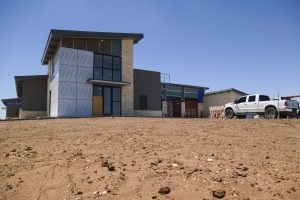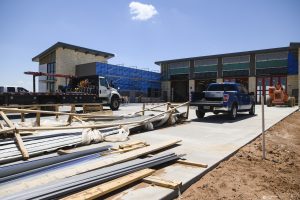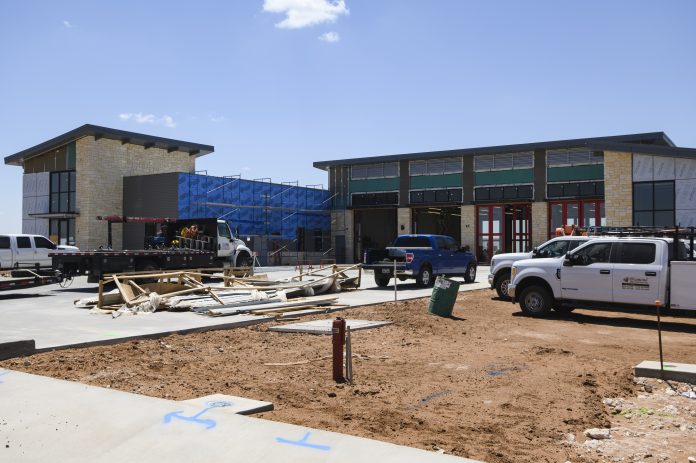When Odessa Fire Station No. 9 opens on East 87th Street at the end of July, it’ll be the first time the city has added another station since 1984 despite the fact it has grown by 17 square miles since then.
That being the case, Odessa Fire Rescue Chief John Alvarez will soon ask the Odessa City Council to hire a firm to confirm his suspicions – Odessa needs two or three new fire stations.
Every year, the OFR responds to roughly 22,000 EMS, fire, rescue and hazardous materials calls from its eight stations, Alvarez said.
Lubbock, which does not handle medical emergencies, responds to 30,000 calls a year and has 19 stations, he said.
Thirty percent of OFR’s calls aren’t even in the city, either, Alvarez said. Due to a contract with Ector County, his firefighter/paramedics are solely responsible for responding to all of the county’s medical emergencies and they are dispatched simultaneously to fire and rescue calls with the county’s volunteer fire departments, he said.

That means his 200 or so firefighter/paramedics are actually covering 903 square miles of territory and not just the city’s 52 square miles, Alvarez said.
If the council agrees, the contracted firm will look at the city’s response times within the city limits, where most of the calls originate from and where additional stations should be located, he said.
According to the National Fire Protection Agency, fire departments should strive to be on the scene of emergencies within 5 minutes and 20 seconds and Alvarez said the OFR is not meeting that standard in the Lawndale area and are close to not meeting it in the Parks Bell area east of Faudree Road.
“That’s another area that has continued to grow and has grown quite a bit. There’s a school out there now, IDEA, and that’s a huge school out there and our nearest fire station to that location is Fire Station 5 on Eastridge,” Alvarez said.
Folks in the county have it even worse; they are seeing response times of 10-12 minutes, Alvarez said.
Recognizing the issue, Ector County Commissioner Mike Gardner, whose precinct covers West Odessa, said the commissioner’s court has already agreed to hire the same firm to conduct the same study in the county.
He believes the single stations responding to emergencies in Goldsmith, South Ector County and Gardendale are providing adequate coverage, but he’s positive West Odessa could use another station.
“We know the response times could be better than they are,” Gardner said.
In addition, both Gardner and Alvarez noted there have been too many times when city crews stationed closest to West Odessa are tied up on one call and another call will come in, either in West Odessa or within the city limits.
“We were fighting two structure fires a couple of years ago. We had a full complement of our people out on a structure fire and another one popped in West Odessa. Both of them were in West Odessa and we had a house inside the city limits that was burning and we had no units to send. Me and Assistant Chief (Rodd) Huber were the first ones on scene on that fire and this thing was cooking…we immediately called dispatch and said ‘We need you to send Midland Fire to respond to this.’”
If North Richland Hills in the Metroplex runs out of resources during a fire, they’ve got Hurst, Bedford and other surrounding communities to come help, Alvarez said. Odessa isn’t so lucky. Midland Fire is 15, 20 minutes away.
Alvarez also pointed out that because there aren’t enough fire stations, crews often have to cover for each other within the city limits.
Seventy percent of the OFR’s calls are medical calls and it takes a lot of time for paramedics to stabilize a patient, take them to the hospital, write their report, disinfect the ambulance, restock the ambulance and get back into service, he said. Complicating matters is the fact fire trucks often have to go to the hospital with the ambulance crew because they’ve got to provide a ride back for the paramedics.
“We usually send the fire truck on calls because it’s more manpower. It’s hard for me to run a code on a cardiac patient with two people, which is what an ambulance has. But if I’ve got four people now I’ve got somebody that can drive that ambulance while I’m in the back working with my partner and another individual and being able to provide that good quality pre-hospital care that we provide,” Alvarez said.
There are additional risks to be considered when having to respond to calls further away than normal, Alvarez said. There’s not only the wear and tear on the $1 million fire trucks, but there’s also the safety risks associated with traveling through traffic with lights and sirens on, he said.

The city must also consider OFR’s other needs soon, Alvarez said. Station Two on East Murphy Street and Station Three near UTPB are starting to show wear and tear and they are also about one third the size of the average modern fire station at just 5,000 square feet, he said.
Alvarez said the city manager and council have always been supportive of OFR, but he thinks it’ll take much more than their support to see to the department’s needs. It’ll take the support of the community.
“If we’re ever going to move forward with anything we do in this city, whether it’s our infrastructure, when it comes down to these water lines, whether it’s our parks department, any of our streets, our fire stations, police department, it’s going to take something above that to make to these changes,” Alvarez said. “Yes, we have a certain tax rate, but at what point do we continue to operate in that tax rate? If we don’t ever do something, if we don’t ever grow that, we’re never going to move as a community when it comes to services. We will never progress and that’s unfortunate because it affects the citizens. Nobody likes taxes. I don’t like taxes, but it’s a necessary evil.”
As for a new fire station in West Odessa, Gardner said the county could consider seeking bonds or raising sales taxes, but he’s in favor of annexing and creating a fire district that would be supported by property taxes. By doing so, West Odessa could have a professional fire department and ambulance service.
Resident’s insurance rates would see an immediate drop in price if that were to happen, he said.
In the meantime, however, Gardner said he will be pushing for some of the county’s American Rescue Plan Act money to be put toward the county’s volunteer fire departments and the Ector County Utilities District for improved water service.
“Water right now is such a huge thing. We have just seen what happens when the water system goes down,” Gardner said. “I don’t know how it could not be at the top of the list, followed by fire right afterward.”




